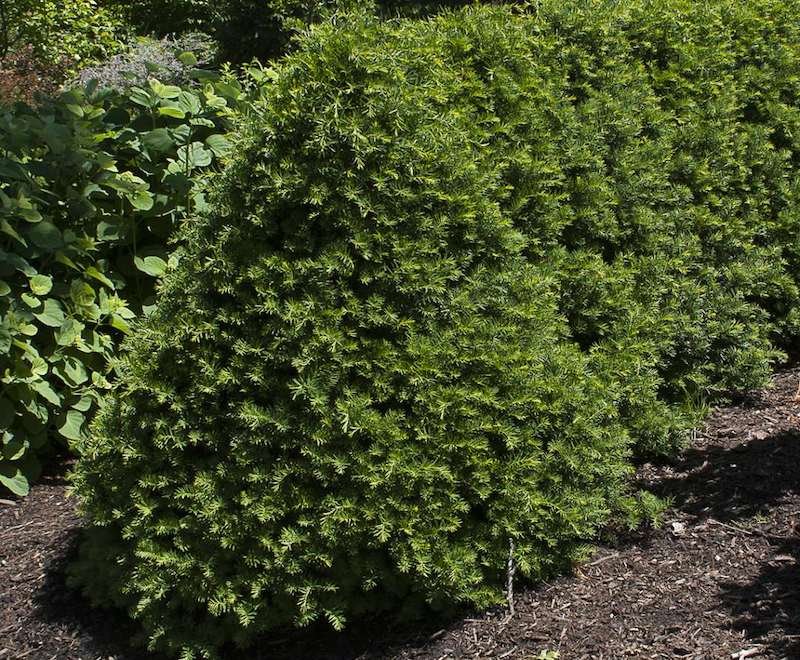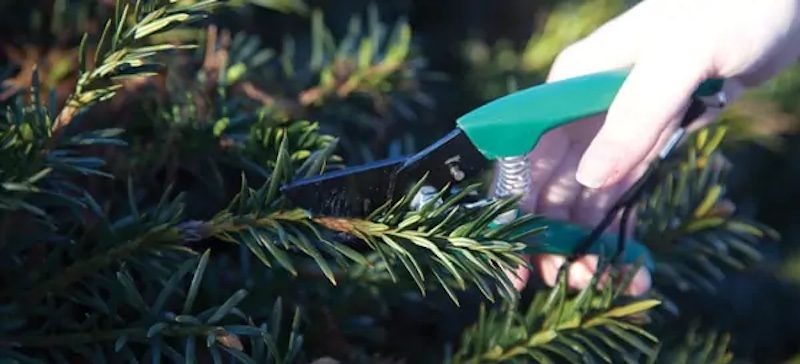Yews, assorted species and cultivars in the genus Taxus, are often prized as hedges and foundations plantings. They respond well to routine pruning to maintain an attractive, tidy form. Yews benefit from routine annual pruning each spring to remove leggy and winter-damaged branches. Early-season shearing also encourages more new shoots that lead to a denser appearance.
Understanding the growth habit of a particular yew will also help to guide pruning decisions. Many cultivars are naturally compact and will have either a rounded or more upright habit. So, even though yews can tolerate heavy shearing, it may be best for the plant’s health and appearance to shape the plant in a way that reflects its natural growth habit.

When to Prune Yews
The best time of year to prune yews is in spring through early summer. Timing pruning for early spring will hide pruning cuts quickly as new growth emerges. It is also possible to shear yews in late spring or early summer. Unlike some evergreens that do not handle pruning well or have a single flush of springtime growth (e.g. pines), yews continue to grow throughout the growing season. Avoid any routine pruning after mid-summer. Pruning late in the year can encourage a flush of tender new growth poorly prepared for winter.
Yews may outgrow the space they are intended for. Whenever growth is out of control, it is possible to make more drastic corrective cuts. While yews do form buds on lower, woody portions of the plant, this growth is slow. Rejuvenation pruning should be done no more than every 3-5 years. The ideal time to do this type of pruning is in spring. Minor pruning to remove damaged or diseased branches can occur as needed.

Why Prune Yews
Broadly, yews are pruned to keep the plant healthy and attractive. This involves removing dead, diseased, and damaged portions of the yew as problems arise. When multiple branches rub together, one or both branches become vulnerable, so one must be removed. Routine pruning keeps the yew the desired size and removes any particularly leggy, tall branches that give the plant an untidy appearance. Shearing encourages dense outer foliage. This type of pruning is commonly used on yews grown as hedges. Overgrown, messy yews also benefit from harder rejuvenation pruning.

How to Prune Yews
Step 1 - Gather and prepare tools.
Use only clean, sharp loppers or hand pruners. For shearing, gather hedge trimmers and make sure they are in good working order.
Step 2 - Cut off leggy growth.
Remove any branches that are growing out of bounds. Make an angled cut just above a branch or bud on a stem, if possible. Step back regularly to check your work and determine where to make more cuts.
Step 3 - Shear the yew.
If the yew is used as a hedge or a foundation planting where straight, even tops and sides of the plant are desired, use a manual or powered hedge trimmer to shear several inches of growth off the top and sides of the plant. Always leave the bottom of a yew at least slightly wider than the top of the plant; this will ensure light reaches bottom foliage.
Step 4 - Perform maintenance pruning.
Inspect the yew occasionally for damaged, broken, diseased, or overgrown branches. Remove these as they appear.
Yews Pruning Tips
- Sharpen and maintain tools well
- Avoid late-season pruning
- Cut back leggy shoots as they appear.
- Shearing every other or every third year creates a compact, dense yew
 |
Author Angela Ryczkowski - Published 4-10-2023 |
